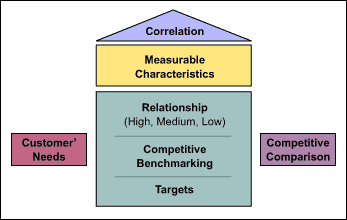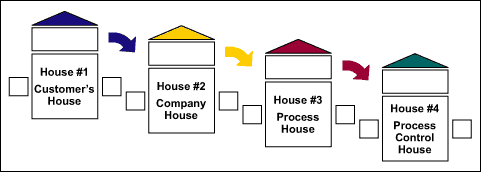
In today’s business environment, companies cannot just assume they know what customers want – they must know for sure. And once they know what customers want, businesses must then provide products and services to meet and exceed customers’ desires. Business leaders have struggled for years to meet this challenge. Having the ability to truly listen to the voice of the customer (VOC) and respond to it appropriately is one good definition of a successful business, a business with a competitive advantage.
Companies which use Six Sigma employ the voice of the customer – internal and external customers – as a key element in implementing their business strategies. So important is VOC data, that no Six Sigma project should proceed without first ensuring it is real, factual, relevant and correlates with the goals of the business. There is a useful and structured tool that helps to translate both spoken and unspoken customer requirements into key business deliverables. This tool is quality function deployment (QFD).
Focusing on ‘Positive Quality’
Many quality tools focus on “negative quality” – the things that disappoint the customer. One of the key distinctions about QFD is it focuses on “positive quality” – things that delight a customer. It looks at the items that please the customer and expands upon them. QFD is useful for cross-functional teams which have to agree on what is important.
QFD is useful in a number of different scenarios. Some examples are when:
- A business knows the customers’ requirements but does not have adequate internal measurements relative to the requirements.
- The internal processes and practices of a business cannot meet the customers’ requirements.
- A large investment is required for a new product or service.
- There is a lack of agreement within a business organization on how to proceed in delivering customer requirements.
- There are competing alternatives for market segments.
QFD Around for Nearly 40 Years
QFD is not something new, but a tool that has been in existence for quite some time. Japanese professors Yoji Akao and Shigeru Mizuno developed it in the late 1960s. Their goal was to develop a tool that would design customer satisfaction into a product prior to being manufactured. Most other quality control methods of the time focused on fixing manufacturing problems after the fact.
QFD was first introduced to America and Europe in 1983. American automotive manufacturers, Ford Motor Company and General Motors Corporation soon adopted it. Later, other American companies such as General Electric, IBM and AT&T started using this tool and reaping the benefits associated with it. QFD has been successfully used in all types of industries and business functions with great success. For instance, it has been used in sales organizations to improve their top line growth.


How does a company apply the methodology of QFD? The most important step in doing a QFD is to properly select the team. The size of the team is not as important as the quality of the team members. The team should be cross-functional and should consist of all of the necessary stakeholders crucial to the team’s success. In addition, it is important to have the customer participate in the team. In doing so, the company will ensure that the customer’s needs and wants are clearly understood and addressed. The QFD process tends to be dynamic in nature. Hence it is wise to consider changing the team members as the company cascades through the four different houses of the QFD process.
Completing the QFD Process
The QFD process typically consists of four steps:
First House of Quality – House 1 is the customer house. In the customer house, the primary goal is to translate the voice of the customer into unambiguous and clear language. A business must understand what measurements the customer is using to determine if it has met their requirements. Next, the company must identify it’s internal metrics which determine if it has met the customer requirements.
Key elements that are critical to completing the first house are:
- Customers’ needs.
- Measurable characteristics of the customers’ needs.
- The relationship between items 1 and 2 measured in high, medium or low.
- An understanding of how the company compares to competitors (from the customers’ perspective).
- Competitive benchmarking.
- Preliminary measurement targets that will meet the customers’ requirements.
Once the company has identified the key elements above, it can perform a correlation between the measurable characteristics of the customers’ needs and their relative strengths. Finally, the company should analyze this first house to determine what improvements can be made.
Second House of Quality – House 2 is the company’s house. This house is typically constructed during the Measure and Analyze phases. The goal of completing the second house is to determine specific action items that the company can take to meet the requirements of the customer.
Third House of Quality – House 3 is the process house and is typically constructed during the Analyze phase. The goal of completing the third house is to determine which processes (that have data) can be used to meet the customers’ needs. It is possible that the process does not exist, so it may need to be developed.
Fourth House of Quality – House 4, the process control house, is typically constructed during the control phase. The purpose of constructing this house is to identify the control variables that are being used to meet the customers’ needs.
It is not necessary to construct all four houses every time that a QFD is performed. Judgment is needed to determine which houses are needed.
Conclusion: Helping Satisfy the Customer
So why should a company use QFD? It should be used because it is aimed at satisfying the customer throughout the whole business process from product/service development to delivery. It helps organizations reach agreement on measurement systems and performance specifications that will meet customer requirements. It is designed to improve a company’s strategic competitiveness. It also prioritizes the steps that a business must take in order to satisfy the spoken and unspoken requirements of the customer.
In essence, utilizing QFD helps businesses gain a competitive advantage.